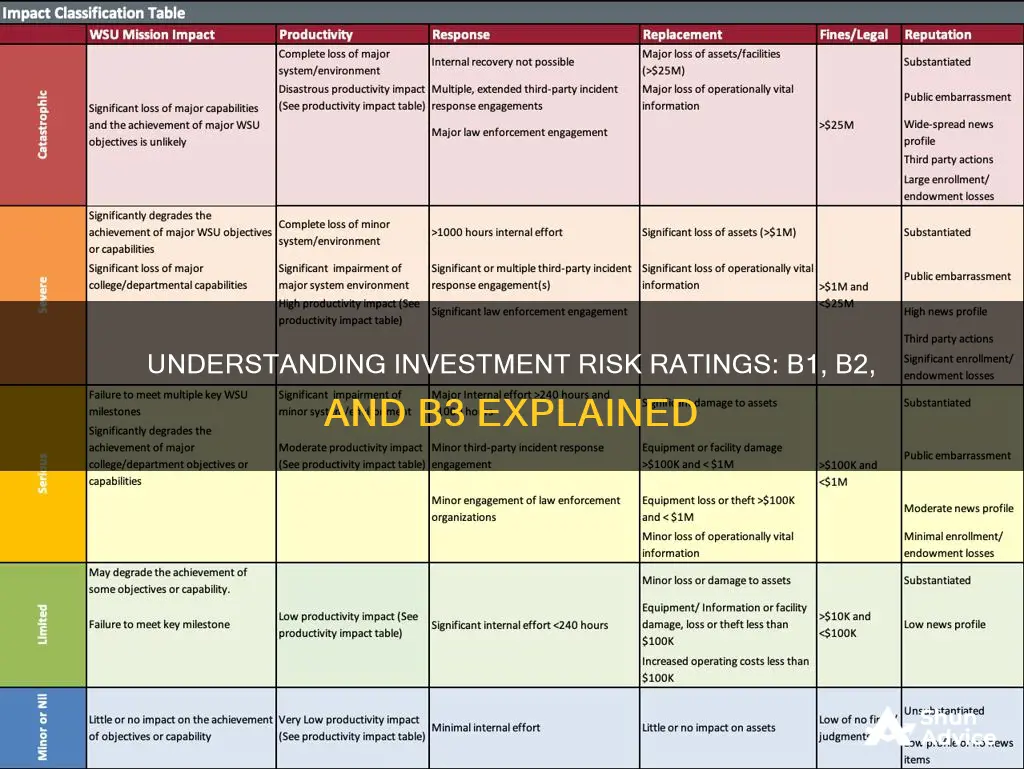
Credit rating agencies assign letter grades to companies, issuers, and securities to indicate their creditworthiness. The three main agencies are Moody's, Standard & Poor's (S&P), and Fitch, which together control approximately 95% of the ratings business. Their ratings are considered opinions rather than investment recommendations. While Fitch and S&P grade companies on a straight A-D scale, Moody's scale uses a mix of letters and numbers. B1, B2, and B3 are non-investment grade credit ratings used by these agencies for issued debt instruments or the issuers of credit. These ratings indicate that the issuer is relatively risky, with a higher-than-average chance of default.
| Characteristics | Values |
|---|---|
| Credit rating | B1/B+ |
| Rating agencies | Moody's, Standard & Poor's (S&P), and Fitch |
| Description | One of several non-investment grade credit ratings (also known as "junk") |
| Issuers | Company, fixed-income security, or floating-rate loan (FRN) |
| Probability of default | Higher-than-average |
| Relative risk | Risky |
| Quality | One of the highest ratings in the non-investment grade bracket |
What You'll Learn
- B1/B+ ratings are below investment grade, but still one of the highest ratings in the non-investment grade bracket
- B1/B+ ratings are assigned to companies, fixed-income securities, or floating-rate loans
- B3/B- ratings are at the bottom end of junk bonds
- B3/B- ratings indicate a higher risk of default and greater risk to investors or policyholders
- B1/B+ and B3/B- ratings are assigned by Moody's, S&P, and Fitch

B1/B+ ratings are below investment grade, but still one of the highest ratings in the non-investment grade bracket
B1/B+ ratings are non-investment grade credit ratings, otherwise known as "junk" ratings. These ratings are assigned by major credit rating agencies such as Moody's, S&P Global Ratings, and Fitch Ratings. While B1/B+ ratings are below investment grade, they are still one of the highest ratings in the non-investment grade bracket. Moody's assigns B1, while S&P and Fitch use B+.
Credit ratings are generally divided into two categories: investment grade and non-investment grade. Investment-grade ratings indicate a higher quality rating with a reduced risk of default, while non-investment grade ratings constitute higher-risk investments with an increased risk of default. The boundary between investment grade and non-investment grade is BBB-.
B1/B+ ratings are considered speculative, indicating a relatively risky issuer with a higher-than-average chance of default. They are among the highest-quality speculative ratings, just below Ba2/BB and Ba3/BB+. Companies with B1/B+ ratings tend to face higher borrowing costs compared to those with higher credit ratings, as investors demand higher yields to compensate for the increased risk of default.
The B1/B+ ratings are crucial for investors when assessing the creditworthiness of a company or bond, as well as the associated risks. These ratings provide valuable insights into the risk profile of issuers, helping investors make informed investment decisions. While B1/B+ rated securities offer higher yields, they also come with increased risk. Therefore, investors should carefully consider the possibility of default and conduct thorough due diligence to mitigate these risks effectively.
Importing Your Portfolio to Investing.com: A Step-by-Step Guide
You may want to see also

B1/B+ ratings are assigned to companies, fixed-income securities, or floating-rate loans
Moody's uses the B1 rating, while S&P and Fitch use B+. B1/B+ are among the highest-quality speculative ratings, falling just below ratings like Ba2/BB and Ba3/BB+. Companies with B1/B+ ratings tend to have higher borrowing costs compared to those with higher credit ratings, as investors demand higher yields to compensate for the increased risk of default.
The B1/B+ ratings are influenced by various factors, including the financial health of the issuer, industry outlook, and market conditions. Credit rating agencies assess financial metrics such as leverage ratios, liquidity positions, and profitability to gauge the issuer's ability to meet debt obligations. Industries facing economic challenges or regulatory uncertainties may also receive lower ratings.
B1/B+ rated securities offer higher yields to investors but come with increased risk compared to investment-grade securities. Investors seeking higher returns may find B1/B+ rated securities attractive, but it's crucial to carefully consider the associated risks, including the possibility of default and lower recovery rates.
Overall, B1/B+ ratings provide valuable insights into the creditworthiness and risk profile of issuers, helping investors make informed investment decisions about companies, fixed-income securities, or floating-rate loans.
Background Checks: Vetting Investment Managers
You may want to see also

B3/B- ratings are at the bottom end of junk bonds
The B3/B- rating is the lowest rating that most investors will accept within the realm of junk bonds. The next step below are C-rated bonds, which are considered highly speculative and extremely risky. Therefore, the B3/B- rating represents a critical threshold for investors when assessing the riskiness of their investments.
Entities with a B3/B- rating may be experiencing financial instability or may not have adequate cash reserves relative to their business needs, debt obligations, or other financial commitments. This rating suggests a higher risk of default, indicating that investors or policyholders are exposed to a greater risk of losing their principal investments. Consequently, investors demand a higher yield for purchasing these high-risk bonds as compensation for taking on this elevated level of risk.
The B3/B- rating falls within the "highly speculative" subset of junk bonds. The probability of an issuer defaulting on their bond interest payments is over 20%, with only about 20% of defaulting issuers resuming payments later, known as the "recovery rate." This high risk of default necessitates a higher yield, or risk premium, to attract investors to these bonds. The magnitude of the risk premium is influenced by market conditions and the risk-free rate of return, often represented by the 10-year Treasury yield.
Exchange Rate Impact on Investor Confidence and Decisions
You may want to see also

B3/B- ratings indicate a higher risk of default and greater risk to investors or policyholders
B3/B- ratings are assigned to companies, issuers, and securities that are speculative and carry a greater degree of risk than investment-grade bonds. These ratings are given by the three main credit rating agencies: Moody's, Standard & Poor's (S&P), and Fitch. While S&P and Fitch use the B- rating, Moody's employs the B3 rating.
B3/B- rated bonds are at the bottom end of the high-yield bonds spectrum, just above C-rated bonds, which are the riskiest junk bonds. This rating signifies a higher risk of default and greater uncertainty for investors or policyholders. Entities with this rating may be experiencing financial instability or may not have adequate cash reserves to meet their business needs, debt obligations, or other financial commitments.
The risk of default for B3/B- rated bonds is over 20%, and only about 20% of defaulting issuers resume payments later, known as the "recovery rate". To compensate for this high risk, B3/B- rated bonds offer higher yields compared to investment-grade, low-risk bonds. This higher yield is called the risk premium, which varies based on market conditions and the risk-free rate of return, often represented by the 10-year Treasury yield.
The B3/B- rating is part of the “highly speculative” subset of junk bonds, indicating a higher risk of default and greater risk exposure for investors. This rating serves as a cautionary indicator for investors, highlighting the potential financial instability of the rated entities.
National Pension Scheme India: Investing for a Secure Future
You may want to see also

B1/B+ and B3/B- ratings are assigned by Moody's, S&P, and Fitch
B1/B+ and B3/B- are credit ratings assigned by the three main credit rating agencies: Moody's, S&P, and Fitch. These agencies assess the creditworthiness of companies, fixed-income securities, or floating-rate loans (FRN) and assign letter grades to indicate the risk associated with investing in them.
Moody's uses the B1 rating, while S&P and Fitch use B+. B1/B+ is a non-investment grade rating, also known as "junk", indicating that the issuer is relatively risky with a higher-than-average chance of default. It is one of the highest-quality speculative ratings, following Ba2/BB and Ba3/BB+.
For the B3/B- rating, Moody's uses B3, while S&P and Fitch use B-. This rating is assigned to companies, issuers, and securities that are considered speculative and carry a greater degree of risk than investment-grade bonds. In the world of junk bonds, a B3/B- rating is about as low as a rating as most investors will accept. B3/B- signifies a higher risk of default and greater risk to investors or policyholders.
The credit ratings assigned by these agencies are interpreted as measuring the probability of default for a given issuer or issue. They are meant to be indicators of the ratee's creditworthiness, measuring both ability and willingness to pay. These ratings are considered opinions rather than investment recommendations.
Transferring Your Investment HSA to Savings: A Step-by-Step Guide
You may want to see also
Frequently asked questions
B1 is a non-investment grade credit rating used by Moody's, one of the three main credit rating agencies, along with S&P and Fitch. B1-rated companies are considered relatively risky, with a higher-than-average chance of default.
B2 is a non-investment grade credit rating, also known as "junk", assigned by S&P and Fitch. It is one of the highest-quality speculative ratings, following Ba2/BB and Ba3/BB+.
B3 is a speculative and risky credit rating assigned by Moody's. It is one of the lowest ratings most investors will accept. B3-rated companies may be experiencing financial instability or have inadequate cash reserves.







